TABLE OF CONTENTS
Quick Start
Watch these videos to get up and running quickly with Replay Media Catcher:
In most cases, catching online media is as easy as clicking the AUTO switch to the On position. 
If this is the first time you are using Replay Media Catcher 6 (RMC6), you may get a notice about our SSL Scanner. This helps facilitate capturing streaming media over HTTPS connections. RMC6 will then watch for streaming media as you browse the internet. If streaming media is recognized, it will be saved to your computer. For more information, please read Capture Method - Stream Downloader.
If you don't want RMC6 to constantly watch for streaming media, turn AUTO to the Off position: 
For On Demand saving of media, Drag & Drop or Copy & Paste the webpage URL into the URL Download field.

RMC6 will then find the media on the page and save it for you. For more info, please see Saving Online Media with the URL Bar and DVR Online Videos with the URL Bar.
If the media playing in your browser (or via the Drag & Drop or Copy & Paste method) cannot be saved, the media is likely protected. In these cases, use RMC6's Audio Recorder or Digital Video Recorder features to save the media.
Tutorials
When you first launch Replay Media Cather 6, you are presented with an overview of the software and an opportunity to do a guided walk through. This walk though is highly recommended as it highlights where commonly used features are located.
You can reopen the tutorial screen at anytime via the Main menu icon at the top right  and selecting Tutorial.
and selecting Tutorial.
We also recommend that you view our video tutorials which will acquaint you with aspects of the software:
Video Tutorials
Overview and the Home Tab
Replay Media Catcher 6 is an easy, yet powerful way to capture video and audio files from thousands of web sites as they play in any web browser. These files can be transferred to smartphones or tablets, burned to a CD or DVD disc, or incorporated into other programs like PowerPoint or video editors.
Besides being a simple-to-use streaming media recorder, Replay Media Catcher 6 has some other handy features:
- Saves any online video at any available quality.
- Records audio from ANY source as it plays on your PC.
- Automatically converts recorded files to a format of your choice.
- Lets you schedule recordings from any playable URL at a time you choose.
- Has embedded video, music and radio guides to help you find interesting media.
- Uses a Music Fingerprinting technology to automatically identify and tag recorded music MP3 files.
When you start Replay Media Catcher 6 for the first time, the default view is the Home tab for Stream Recording.

RMC6 Main Toolbar
At the top of Replay Media Catcher 6 is a toolbar which adjusts depending on the chosen Capture Method.

When the Stream Downloader Capture Method is chosen, the AUTO button will appear, as in the above screenshot. Please read Capture Method - Stream Downloader for its usage.
At the top right you will find the main toolbar icons for accessing the most common recording features.
The contents of the toolbar are dependent on the current recording method. In the Stream Downloader Capture Method, from left to right, the icons are:
 Registration: If you are still in trial mode, you can register RMC6 using this button. If you are already registered, the button will not appear.
Registration: If you are still in trial mode, you can register RMC6 using this button. If you are already registered, the button will not appear. Capture method selection: The cloud download icon indicates that Stream Downloader is the active capture method. Click this icon to change to other downloading methods.
Capture method selection: The cloud download icon indicates that Stream Downloader is the active capture method. Click this icon to change to other downloading methods. Small interface mode: Clicking this button will shrink RMC6 into a much smaller, streamlined interface.
Small interface mode: Clicking this button will shrink RMC6 into a much smaller, streamlined interface. Output Folder location: Use the Output Folder button to change where you would like media to be saved. This action is also available in Settings.
Output Folder location: Use the Output Folder button to change where you would like media to be saved. This action is also available in Settings. Main menu: The Main Menu button provides an extensive list of program actions.
Main menu: The Main Menu button provides an extensive list of program actions.
RMC6 tabs
Along the left hand side of the user interface you will find tabs for:
 Most of your time will be spent in the Home tab, from which you can view all of your saved media.
Most of your time will be spent in the Home tab, from which you can view all of your saved media. The Guides provide a convenient way to find new media.
The Guides provide a convenient way to find new media. Use Schedule to have Replay Media Catcher 6 record online programs at designated times.
Use Schedule to have Replay Media Catcher 6 record online programs at designated times. Use Settings to customize the behavior of Replay Media Catcher 6.
Use Settings to customize the behavior of Replay Media Catcher 6. The Get Support tab provides more product information and ways to contact us.
The Get Support tab provides more product information and ways to contact us.
RMC6 Home Tab Central Content
The contents of the central area will change depending on the chosen tab. When on the Home tab, all your saved media will be shown in the central file listing section.

- At the top left is the global conversion pulldown. Please refer to the Converting Media Formats section for more information.
- At the top right is a Search field in which you can search though your listing of saved media.
- At the bottom, a generated thumbnail for the media is shown as well as file information. There are icons for
 getting more information,
getting more information,  playing the media,
playing the media,  and revealing the Windows folder in which the media was saved.
and revealing the Windows folder in which the media was saved.
- Across the middle is the saved media listing itself. The name of the media as well as file characteristics are listed. Clicking on the column headers will change the sorting order. Right-clicking on a saved file will bring up a context menu for additional actions.
- Stop: Stop the active download or recording
- Delete: Delete the selected file(s)
- Rename: Rename the selected file
- Remove: Remove the selected file(s) from the listing but do not delete them from the computer
- Play: Launch an appropriate media player for the media type
- Convert: Convert the selected file(s) to the chosen media format in the global conversion pulldown
- Save to MP3: Quickly convert the selected file(s) to MP3 without having to select a global conversion setting
- Combine: Merge the selected files into one continuous file - see Split and Combine for more information
- Fix FLV: Adjust the duration or time stamp for selected file(s) - sometimes necessary for FLV files that have audio/visual synchronization problems
- Restart: Attempt to restart the download/recording - not always possible based on the media source
- Import into iTunes: Send the selected file(s) to iTunes
- Import into WMP: Send the selected file(s) to the Windows Media Player library
- Show in folder: Open a Windows folder to the location of the saved media
- Artwork: Open the file Properties window to show downloaded artwork or generated thumbnail
- Lyrics: Open the file Properties window to show any lyrics that might have been obtained
- Lookup Tags: Query the ROVI database to find artist and album information (a.k.a. ID3 tags)
- Properties: Open the Properties window - see more information about the saved media
Capture Method - Stream Downloader
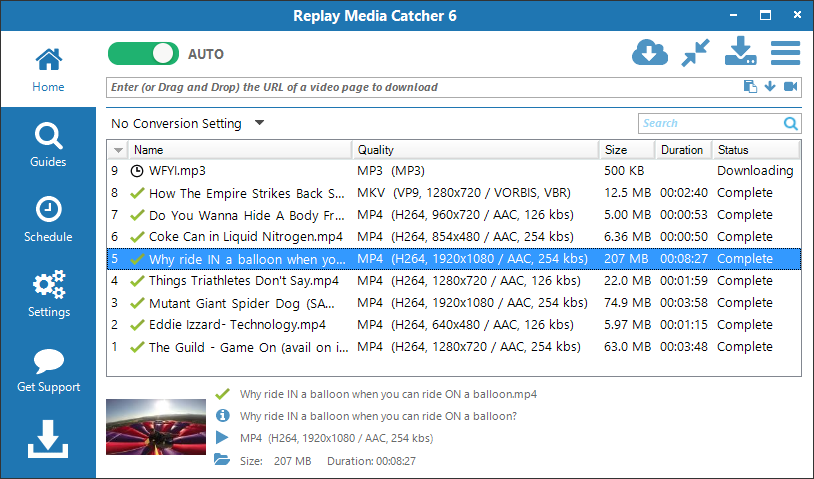
Replay Media Catcher 6 will detect and download video and music from thousands of sites and streamed via many different protocols and in many different formats.Click here for the full list of supported protocols.
Browser Independence
It does not matter what browser or other application you use to watch video or listen to music that is streamed from the internet. This is because Replay Media Catcher monitors the network stream for media, and once detected will download or record the stream.
What is the Difference Between Recording and Downloading Internet Streams?
When Replay Media Catcher detects a compatible stream, it will try and create another connection to download it. When Replay Media Catcher is downloading, there is no need to continue to play the video or music in your browser!
Sometimes it is not possible for Replay Media Catcher to download the media. In these instances, Replay Media Catcher will record the stream as it plays in your browser. When Replay Media Catcher is recording in this manner you must continue to play the video or music in your browser. If you stop playback, then Replay Media Catcher will also stop recording.
Replay Media Catcher displays Downloading or Recording in the Status column of the Home tab for the respective methods. If a stream is protected and cannot be downloaded or recorded directly, then you can use the Audio Recorder (for audio content) or Digital Video Recorder (for video content) Capture Methods to save the media.
Monitoring For Internet Streams with AUTO
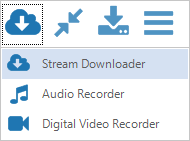 You must start monitoring BEFORE you watch or listen to media that you want to capture. First, make sure that the capture method at the top right is set to Stream Downloader, as seen to the right. Click on the AUTO switch before browsing to the media you want to capture. Once clicked, the AUTO switch will turn slide right and turn green
You must start monitoring BEFORE you watch or listen to media that you want to capture. First, make sure that the capture method at the top right is set to Stream Downloader, as seen to the right. Click on the AUTO switch before browsing to the media you want to capture. Once clicked, the AUTO switch will turn slide right and turn green  .
.
Saving Online Media with the URL Bar
You can perform manual downloads using the URL bar, found directly beneath the AUTO switch. As the hint text suggests, you can manually type in a URL, copy & paste a URL, or drag & drop a URL into the text field. If you already have a URL copied to the Windows clipboard, you can also use the  clipboard button at the end of the URL field. Then click the Enter key or press the
clipboard button at the end of the URL field. Then click the Enter key or press the  download arrow button. RMC6 will visit the URL and attempt to grab streaming media from it. The final
download arrow button. RMC6 will visit the URL and attempt to grab streaming media from it. The final  DVR button in the bar will launch a Digital Video Recording of media at the URL (please refer to Capture Method - Digital Video Recorder for more information).
DVR button in the bar will launch a Digital Video Recording of media at the URL (please refer to Capture Method - Digital Video Recorder for more information).
Media Extractor - Choosing Media Quality
Oftentimes, online media will be streamed in multiple formats and qualities. For compatible streams, RMC6 will detect the different available media formats and give you a choice as to which to save. Expand the formats listing and double-click on the one you want to download. The line will turn green, indicating that the video is queued for download. If you are interested in only saving a particular format or quality all of the time, you can act on those preferences with the Preferred Download Quality and Preferred Download Format options at the bottom of the window.
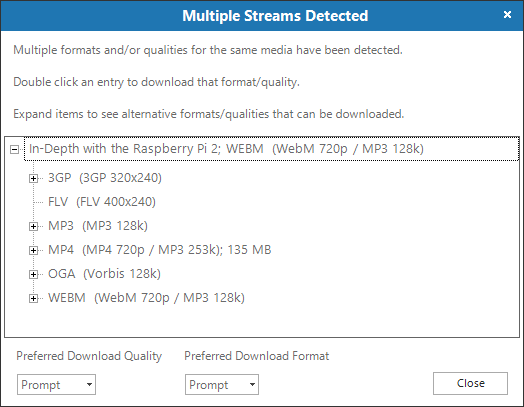
If you change you mind about preferred formats, you can reset the preference in Settings -> Internet Downloads.
File Naming
Please refer to Settings -> Naming Rules and Advanced Settings
Capture Method - Audio Recorder
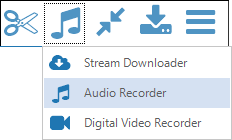 Audio recording is a great way to capture music when downloading fails. Saving audio using this method will work, regardless of the format, protocol, or web site of the media.
Audio recording is a great way to capture music when downloading fails. Saving audio using this method will work, regardless of the format, protocol, or web site of the media.
First, switch to the Audio Recorder by changing the Capture Method in the top right toolbar. The green bullseye  RECORD button will appear at the top left.
Once clicked, the RECORD button will turn to a red square STOP button
RECORD button will appear at the top left.
Once clicked, the RECORD button will turn to a red square STOP button  , but RMC6 will be actively monitoring for audio media. When RMC6 is actively recording audio, the VU meter will animate at the lower left of the interface, and the recording will be seen in the Home tab.
, but RMC6 will be actively monitoring for audio media. When RMC6 is actively recording audio, the VU meter will animate at the lower left of the interface, and the recording will be seen in the Home tab.
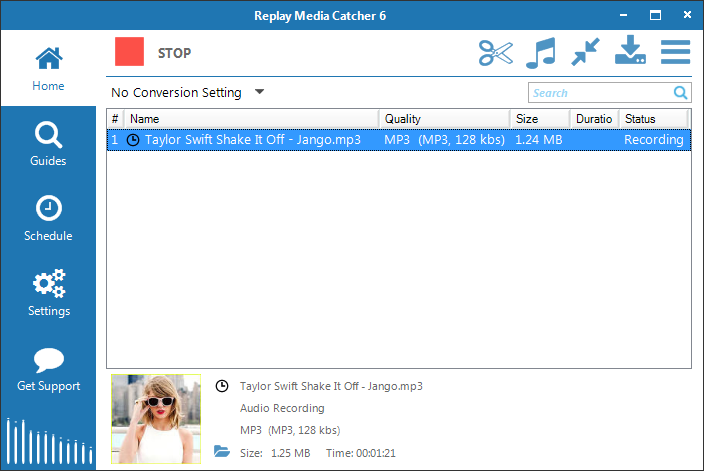
Splitting and Combining Recordings
While recording, you may wish to begin the creation of a new file, ending the first, without stopping the recording process. This is easily achieved using the Split Now scissors icon in the toolbar  .
.
Sometimes, based on the automatic silence detection settings (see Settings -> Audio Recording and DVR), a recording might be accidentally split into two or more files. Alternately, you may want to join multiple files together to make a long recording. In the Home tab, simply select the files you wish to combine, right-click and choose Combine. The Combine window will appear. Reorder the recorded clips as appropriate by dragging and dropping them, with the top-most item being the first. Give a name for the combined recording, and press the Combine button.
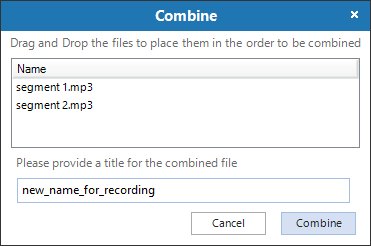
The Combine option can also be accessed via the Main Menu icon  or by pressing the + key on your keyboard's number pad.
or by pressing the + key on your keyboard's number pad.
Small Interface
If you are capturing a lot of media from the internet (a playlist of songs for instance) then you may wish to use the Small Interface by clicking  in the toolbar. The main interface will disappear and the Small Interface will appear. The progress of active recordings will appear in a movable box at the lower right of the screen. You can turn off this option in Settings -> Personalization -> "Display progress alerts when minimized". The Small interface can be dragged to different locations, and you can return to the Main Interface by clicking
in the toolbar. The main interface will disappear and the Small Interface will appear. The progress of active recordings will appear in a movable box at the lower right of the screen. You can turn off this option in Settings -> Personalization -> "Display progress alerts when minimized". The Small interface can be dragged to different locations, and you can return to the Main Interface by clicking  .
.
Setting the Output Folder
At any time you can change the default output folder that files are saved in by clicking  in the toolbar. You can also change the location via Settings -> Output Folder.
in the toolbar. You can also change the location via Settings -> Output Folder.
Audio Settings and Naming (a.k.a. Tagging) Rules
Please consult the Settings sections on Audio Recording and Naming Rules.
Capture Method - Digital Video Recorder
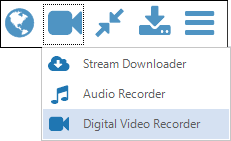 Videos from some streaming websites cannot be directly downloaded or recorded using the Stream Capture method. For these cases, Replay Media Catcher 6 has a powerful Digital Video Recorder feature. In this mode, only one recording can be done at a time. From the Capture Method icon in the top right toolbar, choose Digital Video Recorder. The Digital Video Recorder feature is available on systems running Windows Vista and above.
Videos from some streaming websites cannot be directly downloaded or recorded using the Stream Capture method. For these cases, Replay Media Catcher 6 has a powerful Digital Video Recorder feature. In this mode, only one recording can be done at a time. From the Capture Method icon in the top right toolbar, choose Digital Video Recorder. The Digital Video Recorder feature is available on systems running Windows Vista and above.
DVR Online Videos with the URL Bar

As with the Stream Downloader capture mode, website URLs can be drag & dropped (or copy and pasted) into the URL Bar at the top of the RMC6 interface. The clipboard icon can also be used to paste in a URL that you have copied from a web browser. Then press the
clipboard icon can also be used to paste in a URL that you have copied from a web browser. Then press the  DVR button to the right in the URL bar. RMC6 will go to the site and attempt to make a recording of the video there. If the recording fails, you may need to use our DVR Browser to specifically start the recording, especially if login credentials are necessary.
DVR button to the right in the URL bar. RMC6 will go to the site and attempt to make a recording of the video there. If the recording fails, you may need to use our DVR Browser to specifically start the recording, especially if login credentials are necessary.
DVR Online Videos with the DVR Browser
Replay Media Catcher 6 includes a convenient web browser for making the digital video recording of online media easier. Additionally, some websites require patrons to login to an account in order to watch a video. To open the DVR Browser, click the globe icon in the toolbar  . Our DVR Browser window will open with a convenient list of popular video streaming websites.
. Our DVR Browser window will open with a convenient list of popular video streaming websites.
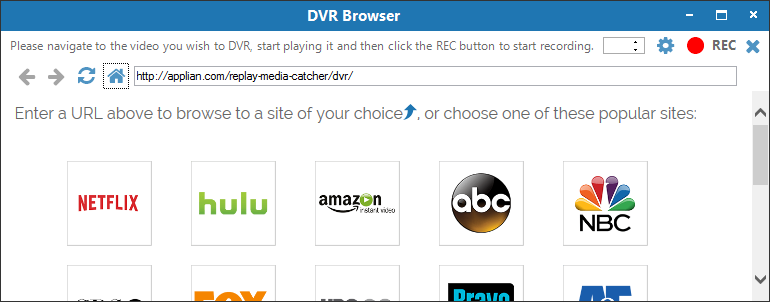
You can click on a thumbnail to go to the listed site, or you can enter a URL of your own choosing in the URL field. Reopening the DVR Browser will take you back to the last site you visited, and the  Home button will return you to this main listing.
Home button will return you to this main listing.
Once you have found a video and it is playing in the DVR Browser, click the  REC button. The browser window will close, and a recording will be done in the background. In the lower left corner of the RMC6 interface, there will be a mini live view of the recording.
REC button. The browser window will close, and a recording will be done in the background. In the lower left corner of the RMC6 interface, there will be a mini live view of the recording.
Note: RMC6 uses audio redirection by default, so there will be no audio. DVR recordings are meant to be done in the background, so there will be no audio playing in the DVR Browser or during an active recording. If you do hear audio from the video, then our audio redirection is not locked into the media or you have turned off the setting. Close and reopen the DV Browser. If you want to hear the audio while a recording is taking place, turn Off the Audio Redirection option in Settings -> DVR.
Additional options:
- Recording Duration: If you want to record for a specific amount of time, enter the number in the
 Recording Duration box at the top right of the DVR Browser window. Recordings will then ignore the silence detection routines (see Settings -> DVR). Be sure to include enough time for any commercial breaks.
Recording Duration box at the top right of the DVR Browser window. Recordings will then ignore the silence detection routines (see Settings -> DVR). Be sure to include enough time for any commercial breaks.
- Settings: Some websites open embedded windows to play their videos. In these cases, you need to turn on the Adjust embedded player for DVR setting via the
 DVR Browser Settings gear icon for recording to occur.
DVR Browser Settings gear icon for recording to occur.
DVR Automatic Silence Detection
RMC6's DVR includes methods to detect if there is silence during a recording. This typically indicates that a video has completed or that a commercial break has been encountered. By default, RMC6 will "split" a recording when silence is detected - a new recording will begin. This conveniently allows you to subsequently delete advertisements and only watch the content you are interested in. Recordings can then be recombined into a single video as previously described for audio recordings. The Split on silence feature can be disabled/enabled in Settings -> DVR. Additionally, if a longer period of silence is detected, RMC6 will completely stop the recording under the assumption that the video has completed. This "timeout" feature can be adjusted in Stop if no sound (sec) in Settings -> DVR. Please refer to the Settings section of this User Guide for more information.
Guides: Exploring the Media Guides
Various Guides are available to help you find Videos, Music, Radio, and Podcasts to download and record.
Some guides provide the ability to download and schedule downloads directly from within the guide itself. Others require Internet monitoring or audio recording to be switched on to capture media as it plays in the guide.
Guides that allow direct downloads can have content scheduled for download or recording. Using the guide for Scheduling ensures correct information is entered into the Scheduler.
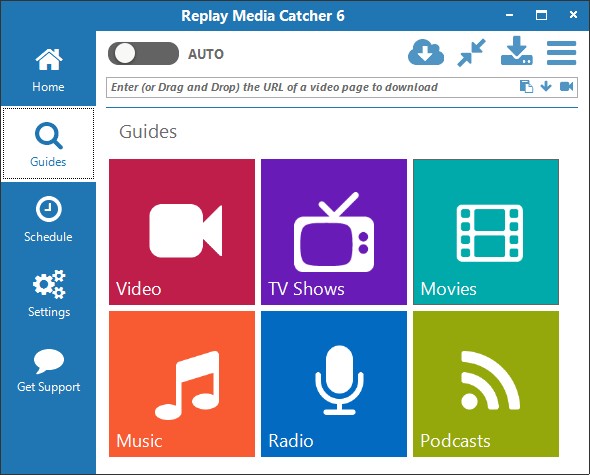
Schedule Recording
Replay Media Catcher contains a sophisticated scheduler, which allows you to schedule regular and unattended downloads and/or recordings. The scheduler takes into consideration the time zone of the source, and also handles changes in daylight savings between the source and you. This is particularly important for regular radio recordings.
Replay Media Catcher does not need to be running when a download or recording is scheduled. It will automatically start using the Windows Task Scheduler.
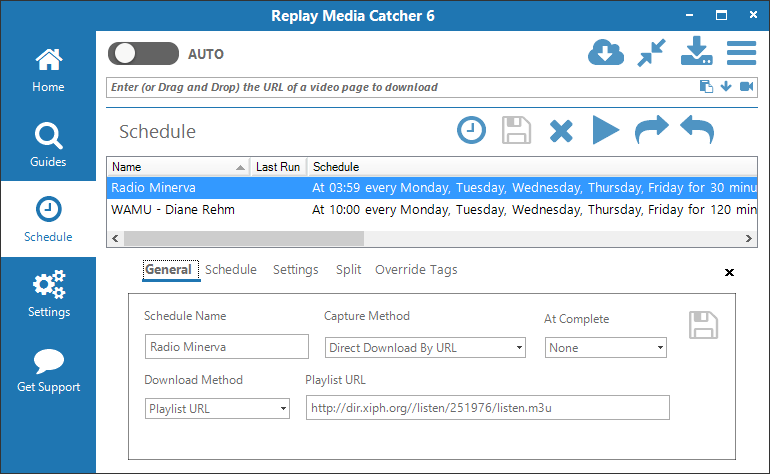
 New Schedule icon: Click the New Schedule icon to create a new schedule from scratch, or use the Guides to get initial schedule information.
New Schedule icon: Click the New Schedule icon to create a new schedule from scratch, or use the Guides to get initial schedule information. Save Schedule icon: The Save Schedule icon will only be active when there are changes to a schedule that have not yet been saved.
Save Schedule icon: The Save Schedule icon will only be active when there are changes to a schedule that have not yet been saved.
 Delete Schedule icon: Deletes the selected schedule.
Delete Schedule icon: Deletes the selected schedule.
 Run Now Schedule icon: Clicking Run Now will begin the selected schedule from the current time until the duration set in the Schedule options.
Run Now Schedule icon: Clicking Run Now will begin the selected schedule from the current time until the duration set in the Schedule options.
 Import icon: The Import icon will allow you to import previously exported schedules.
Import icon: The Import icon will allow you to import previously exported schedules.
 Export icon: The Export icon will allow you to save a file to your computer containing all the details of your recording schedule.
Export icon: The Export icon will allow you to save a file to your computer containing all the details of your recording schedule.
You can configure a scheduled download or recording as follows:
- General tab
- Schedule Name: This is the name of the scheduled recording/download. You can also use the following curly bracketed parameters to add start time information to the file name: {D} - day, {M} - Month, {Y} - year, {H} - Hour, {MI} - minute, {S} - second.
- Capture Method:
- Audio Record (Application): Audio recording will be switched on and the URL will be opened in the default browser. Whatever is streamed will be captured.
- Audio Record (Device): Audio recording will be switched on for content from external device such as Line In or Microphone. Consult Settings->Audio Recording for selecting the device.
- Audio Record (What You Hear): Audio recording will be switched on and all detected audio on your system will be recorded.
- Auto Detect Download: The Stream Downloader capture method will be activated and a browser window will open to the desired URL. Whatever is streamed will be captured.
- Digital Video Record: The Digital Video Recorder capture method will be activated and a recording will begin for the desired URL.
- Direct download by URL: The URL will be downloaded directly. This is most useful for audio sites that provide a perpetual stream address.
- At Complete: Choose the behavior of Replay Media Catcher when the scheduled item has completed recording:
- None: Take no additional action.
- Quit application: RMC6 will be closed.
- Stop Capture: The current recording method will be stopped.
- The remaining, second row of options in the General tab are dependent on the Capture Method.
Audio Record (Application), Audio Record (What You Hear), and Auto Detect Download
- Launch Url In:
- External Player: An external program, based on Windows Default Programs, will be launched
- Web Browser: Your default web browser will be opened to the website URL
- Windows Media Player: WMP will be launched for handling playback of the stream
- URL: The web URL to be opened containing streaming media
Audio Record (Device)
- Device: A listing of available audio recording devices from your system.
Digital Video Record
- URL: The web URL to be opened containing streaming video.
Direct download by URL
- Download Method:
- Normal URL: A URL with no specific formatting
- Playlist URL: A URL formatted as a playlist
- Radiotime URL: A URL formatted for Radiotime / TuneIn programming
- RSS Feed: A URL to a RSS feed
- Torrent Magnet Link: A URL pointing to a torrent magnet link
- YouTube Channel ID: A YouTube Channel ID
- Normal URL: The direct URL to the streaming media source.
- Schedule tab
- Choose the days of the week on which the scheduled recording will run.
- Timezone: Time zone of the start time. This will be used to schedule the download at the correct time on your machine. Each time a scheduled download occurs, the start time is updated against the time zone to take into account daylight savings changes or your machine and this time zone.
- Start Time: The start time in the given time zone.
- Start Date: Items with published dates after this date will be downloaded. Each time the schedule runs, this date will be updated ensuring only newly published items are downloaded.
- Duration: The duration of the recording after which time it will be stopped. -1 means unlimited duration.
- Settings tab
- Import into iTunes: When On, recording will be imported into iTunes (if in MP3, M4A, M4B, or MP4 format).
- Mute Volume: Mute the computer during recording time.
- Specify output folder: This option gives you the ability to save recordings to a specific location other than the overall media Output folder.
- Convert to this format and quality once complete: Select a preset conversion setting once the download is complete.
- Split tab: Recordings can be spit into smaller files
- Don't Split: Leave recording as one file.
- Split Every X Minutes: At the requested interval, create a new file.
- Split At: Recordings can be split at 8 specific time points during the hour. Use 0 to split at the top of the hour. Leave -1 in the field to not use it.
- Override Tags tab: for formats such as MP3 that support tagging, use these values instead of ones obtained via ROVI database lookup
- A bracketed shorthand can be used to add time and date information to the file. {D} - day, {M} - Month, {Y} - year, {H} - Hour, {MI} - minute, {S} - second
- ID3 Title Tag: Leave recording as one file.
- ID3 Album Tag: At the requested interval, create a new file.
- ID3 Artist Tag: Recordings can be split at 8 specific time points during the hour. Use 0 to split at the top of the hour. Leave -1 in the field to not use it.
Monitor Webcams and Live Streams
Replay Media Catcher contains a sophisticated monitor, which allows you to monitor webcam and live stream pages so that you never miss a broadcast.
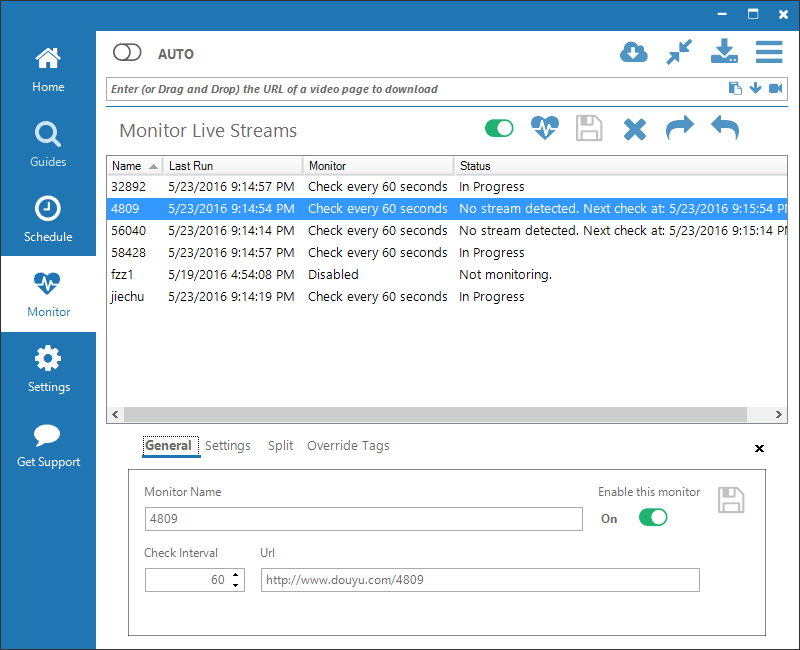
 Start Monitors button: Click this button to start all enabled monitors.
Start Monitors button: Click this button to start all enabled monitors. New Monitor button: Click the New Monitor button to create a new monitor.
New Monitor button: Click the New Monitor button to create a new monitor. Save Monitor button: The Save Monitor button will only be active when there are changes to a monitor that have not yet been saved.
Save Monitor button: The Save Monitor button will only be active when there are changes to a monitor that have not yet been saved. Delete Schedule button: Deletes the selected monitor.
Delete Schedule button: Deletes the selected monitor. Import button: The Import button will allow you to import previously exported monitors.
Import button: The Import button will allow you to import previously exported monitors. Export button: The Export button will allow you to save a file to your computer containing all the details of your monitors.
Export button: The Export button will allow you to save a file to your computer containing all the details of your monitors.
You can configure the web page containing the webcam or live stream to monitor follows:
- General tab
- Monitor Name: This is the name of the monitor. You can also use the following curly bracketed parameters to add start time information to the file name: {D} - day, {M} - Month, {Y} - year, {H} - Hour, {MI} - minute, {S} - second.
- Check Interval: Enter the interval (in seconds) that the page will be checked at for a live broadcast.
- Url: This is the url of the page hosting the live stream. The live stream at this url must be able to be captured using the Page Extraction Method for the live stream to be detected and captured by the monitor
- Enable: This switch enables or disables the monitor
- Settings tab
- Import into iTunes: When On, recording will be imported into iTunes (if in MP3, M4A, M4B, or MP4 format).
- Specify output folder: This option gives you the ability to save recordings to a specific location other than the overall media Output folder.
- Convert to this format and quality once complete: Select a preset conversion setting once the download is complete.
- Split tab
Recordings can be spit into smaller files.
- Don't Split: Leave recording as one file.
- Split Every X Minutes: At the requested interval, create a new file.
- Split At: Recordings can be split at 8 specific time points during the hour. Use 0 to split at the top of the hour. Leave -1 in the field to not use it.
- Override Tags tab
For formats such as MP3 that support tagging, use these values instead of ones obtained via ROVI database lookup.
- A bracketed shorthand can be used to add time and date information to the file. {D} - day, {M} - Month, {Y} - year, {H} - Hour, {MI} - minute, {S} - second
- ID3 Title Tag
- ID3 Album Tag
- ID3 Artist Tag
Settings Tab: Customizing RMC6
The Settings tab allows you customize the behavior of the software. All settings have tooltips when you hover your mouse over them, which will give an indication of their function. If you want to return to the default settings, press the  Reset button at the right, under the main toolbar.
Reset button at the right, under the main toolbar.
Personalization
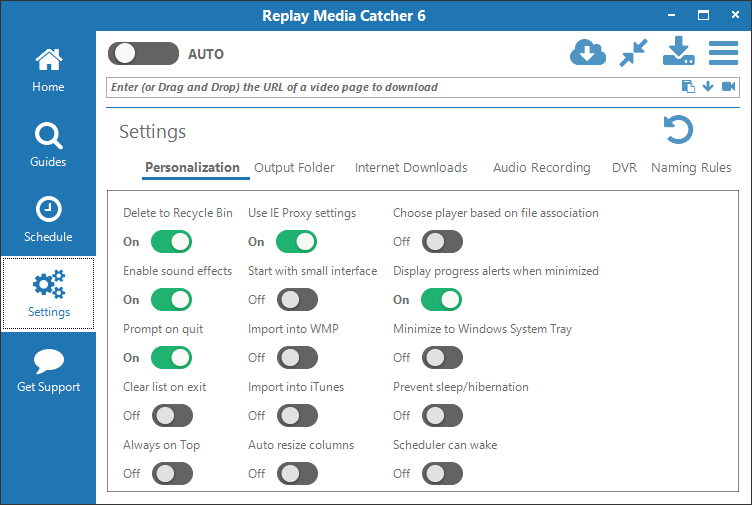
- Delete to Recycle Bin: If ON, deleted files will be sent to the Recycle Bin. If OFF, deleted files will be immediately removed from computer.
- Enable sound effects: If ON, sound effects will be active, and you will get an audible tone when recordings complete.
- Prompt on quit: If ON, you will be prompted by RMC6 when you close the program, giving you a chance to check if there are still running downloads.
- Clear list on exit: If ON, the recording listing will be cleared when RMC6 is quit. Files will not be deleted. If OFF, RMC6 will keep a complete listing of recordings even after multiple sessions.
- Always on top: If ON, RMC6 will attempt to stay above all other windows on your screen.
- Use IE Proxy settings: If ON, RMC6 will use Internet Explorer's proxy settings as determined in Control Panel\Network and Internet\Internet Properties. This is recommended for recording over HTTPS connections.
- Start with small interface: If ON, RMC6 will start in the Small Interface mode.
- Import into iTunes: If ON, all recordings/downloads that are in iTunes compatible formats will be sent to the iTunes Library. If this button is absent, iTunes was not detected on your system. iTunes compatible formats include MP3, WAV, AAC, and MP4/M4V.
- Auto resize columns: If ON, the columns on the Home tab will automatically resize based on the length of each recording's name and details.
- Choose player based on file association: If ON, playing a file from within RMC6 will launch an appropriate player based on Windows' default settings. If OFF, the Applian FLV and Media Player will attempt to be launched.
- Display progress alerts when minimized: If ON and RMC5 is minimized or in Small Interface mode, a movable progress window will appear on your screen, letting you know the status of the download/recording.
- Minimize to Windows System Tray: If ON, RMC6 will minimize to the System Tray instead of the Windows toolbar.
- Prevent sleep/hibernation: If ON, your computer's sleep & hibernation settings will be disabled.
- Scheduler can wake: If ON, scheduled recordings will wake your computer so that the recording is not missed due to being asleep.
Output Folder
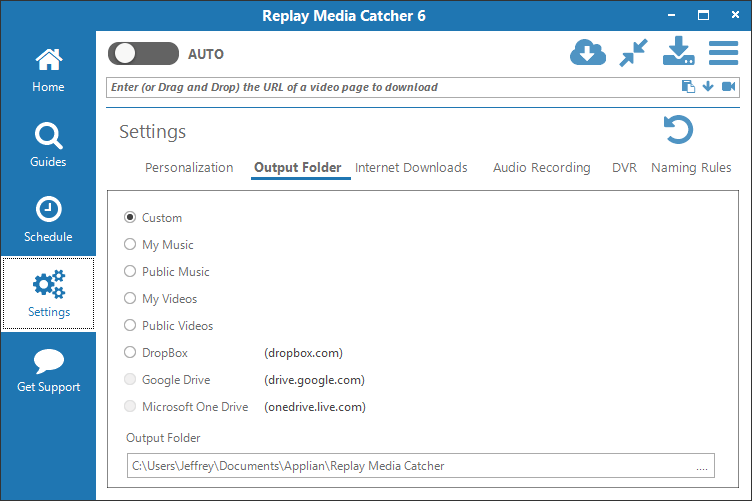
By default, your recordings will be placed into an Applian\Replay Media Catcher folder inside your Documents folder. You can easily change to a number of different common folders. If you have a "cloud" service installed, RMC6 will recognize it and provide that as a save location option as well. Links for three common cloud services are supplied if you wish to install them.
If you want a Custom location for saving the downloaded and recorded media, make sure the Custom radio button is selected. Then, at the bottom in the Output Folder field, enter the location you would like to save media to. You can also click on the ellipsis, "...", at the end of the line to bring up a folder navigator for choosing a location.
Internet Downloads
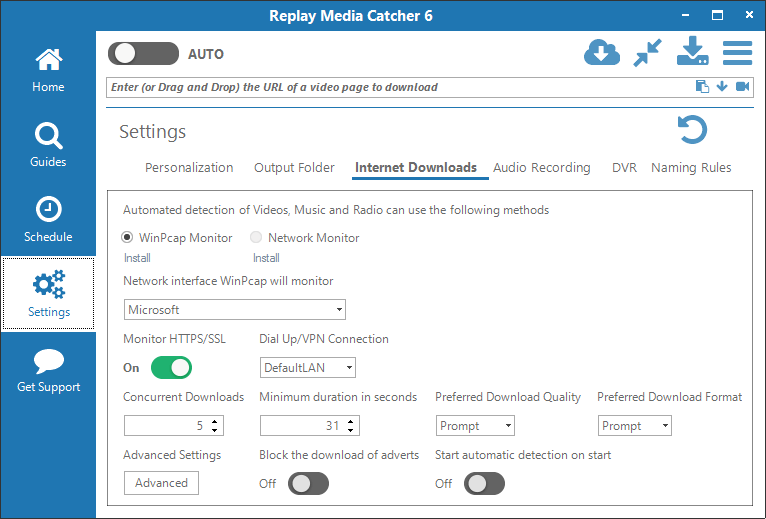
When you turn on the Auto mode for Stream Downloading, RMC6 will watch network traffic for data that looks like media. RMC6 does this using either the WinPcap Monitor or Applian Network Monitor driver. If you are not seeing any media being downloaded when Auto is ON, then you may need to switch to the other driver. WinPcap is the preferred driver due to fewer conflicts with other software, and Network Monitor is specifically recommended for downloading media over VPN connections.
- Network interface WinPcap will monitor: Some computers will have multiple network interfaces. WinPcap will typically choose the correct one, but this pulldown can be used to try other interfaces.
- Monitor HTTP/SSL: If you want to download media over HTTPS connections, this setting needs to be ON. RMC6 will then use its proxy + certificate system to allow for downloading from HTTPS websites.
- Dial Up/VPN Connection: Some computers may have multiple network connections, as determined in Control Panel\Newtork and Internet\Internet Options. If RMC6 is unable to download media when Auto is ON, you may need to use this pulldown to see if data is passing through a different connection.
- Concurrent Downloads: The number of simultaneous downloads before additional requests are queued. In general, only increase this for broadband connections > 20 Mbps.
- Minimum duration in seconds: Downloaded media smaller than this duration are considered to be ads and are automatically deleted. Set to -1 to disable feature.
- Preferred Download Quality: For sites that offer multiple streaming qualities, you can have RMC6 prompt you each time for which you would like, or you can have RMC6 automatically download the preferred quality (High, Medium, Low).
- Preferred Download Format: For sites that offer multiple streaming file formats, you can have RMC6 prompt you each time for which you would like, or you can have RMC6 automatically download the preferred format (Any, flv, mp4, 3gp, webm, mkv).
- Advanced Settings: Settings that will not normally need to be edited can be accessed with the Advanced button. Please see Advanced Settings for more details.
- Block the download of adverts: If ON, RMC6 will automatically ignore streaming media from known advertisers. The list of advertiser URLs can be found in Advanced Settings, in which you can add or delete sites.
- Start automatic detection on start: If ON, the Auto mode will be turned on immediately when RMC6 starts.
Audio Recording
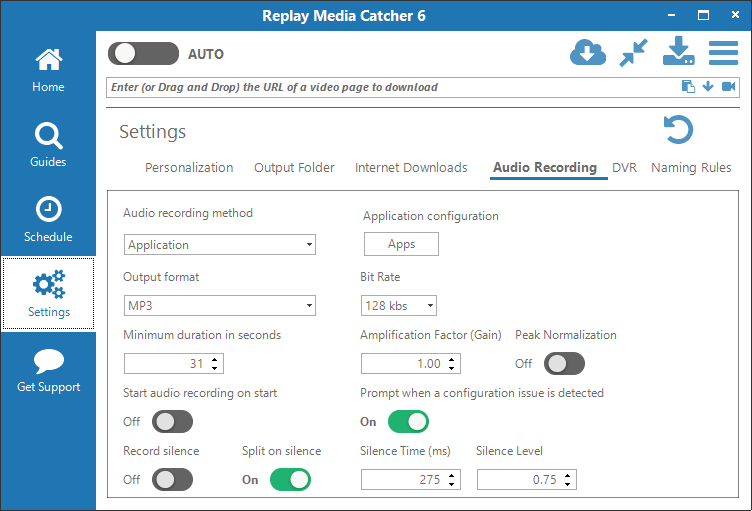
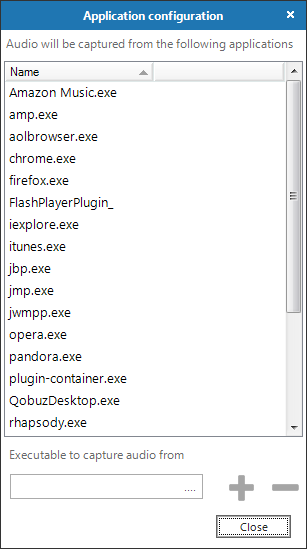
- Audio recording method:
- Application: In the Application recording method, audio is directly pulled out of running applications. The applications from which RMC6 can grab audio are set via the Application configuration Apps button. Windows 8 users will need to have Secure Boot disabled in their UEFI BIOS for this recording method to work.
- Device: When Device is selected, you will be able to choose a hardware device connected to your computer, such as Line In, from which to record audio.
- Stereo Mix (What you hear): When Stereo Mix is chosen, all audio from your computer will be recorded. A Buffer value will be presented, and larger buffer values will reduce CPU load during recording.
- Output format: Choose the audio format you would like to record in.
- Bit Rate: Compressed, constant bit rate Output formats will allow you to choose the bit rate that you would like for recording. Variable Bit Rate (VBR) and uncompressed formats (such as WAV) do not have this option.
- Minimum duration in seconds: Recordings less that this duration are discarded.
- Amplification Factor (Gain): Values less than 1 will decrease the volume of the saved recording. Conversely, the saved audio can be boosted in volume by increasing the Gain above 1.
- Peak Normalization: If ON, the recording will be processed to increase the overall volume such that the loudest part is at 0 dBFS.
- Start audio recording on start: If ON, RMC6 will activate audio recording when first launched.
- Prompt when a configuration issue is detected: The Application recording method requires certain Windows Registry settings to be accurate. Sometimes, other software such as "Cleaners" or antivirus programs will delete the RMC6 settings. If ON, RMC6 will warn you that the Registry is not configured correctly.
- Record silence: If ON, sound that is considered silent based on the Silence Level setting will be recorded. This is usually necessary for audio recordings that include large breaks or gaps in the stream.
- Split on silence: If ON, when silence is detected based on the Silence Time and Silence Level settings, RMC6 will split the current recording and start a new file to continue recording.
- Silence Time (ms): Time, in milliseconds, for which silence needs to be detected for Split on silence to be activated.
- Silence Level: Numbers below this level will be considered silent for the purposes of Record silence and Split on silence.
DVR

- Audio Redirection: If ON, audio will not play during a DVR recording session. If OFF, you will hear the audio as the recording takes place, and you will need to choose an audio source in order for the video to have embedded audio.
- Zoom in on Player: If ON, the video will be zoomed in on for recording. This can result in a larger recording, but it also will require more CPU power.
- Audio Codec: You can choose a specific audio codec if desired.
- Audio Format: You can choose from a wide range of audio qualities. Lower bitrates will give smaller files and use less CPU power.
- Video Codec: You can choose a specific video codec if desired.
- Frames Per Second: Common video frame rates are available. 29.97 is the NTSC standard. Consider reducing the Frames Per Second on older computers, to reduce CPU load, or to reduce file size.
- Stop on Silence: If ON, the DVR will stop recording if silence is detected for Silence Time
- Split on silence: If ON, when silence is detected based on the Silence Time and Silence Level settings, RMC6 will split the current recording and start a new file to continue recording.
- Prompt when a configuration issue is detected: If ON, you will be warned if your system might have difficulty recording with the DVR. Typically this means that Windows Desktop Composition needs to be enabled by choosing an "Aero" desktop theme.
- Silence Check (ms): The interval, in milliseconds, to check to see if there is silence.
- Silence Time (ms): Time, in milliseconds, for which silence needs to be detected for Split on silence to be activated. If Stop on Silence is ON, it is recommended to increase this number to 5000 or greater so that the loading of advertisements does not stop a recording.
- Silence Level: Numbers below this level will be considered silent for the purposes of Stop on Silence and Split on Silence.
- Stop if no sound (sec): The DVR recording will stop if silence is detected for a period of time larger than this value. If you are recording from a site that offers one show after another, you may want to increase this from the default 30 to account for delays between loading of videos.
Naming Rules
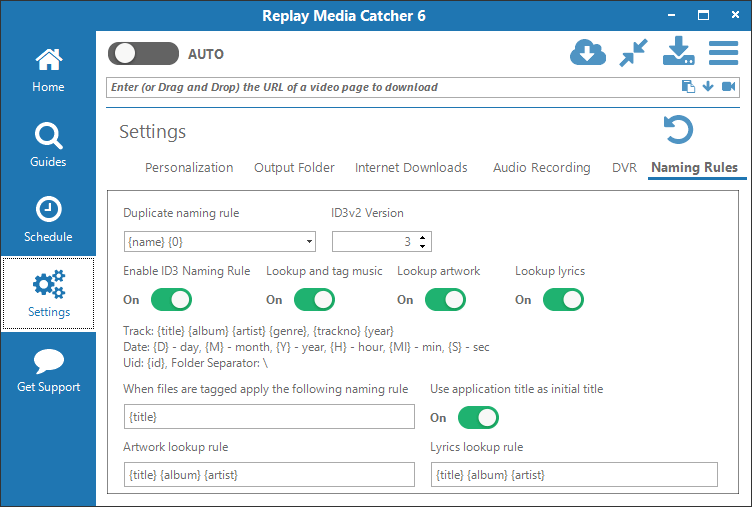
- Duplicate naming rule: If Replay Media Catcher 6 encounters another file in your media folder with the same name, apply this rule to prevent overwriting.
- ID3v2 Version: Windows operating systems don't always recognize the latest ID3 tagging scheme, although iTunes can. If you want to view song tag information in Windows File Explorer, reduce this number.
- Enable ID3 Naming Rule: When ON, recordings will be renamed based on the ID3 tag information.
- Lookup and tag music: When ON, audio recordings will be checked against an online music database for determining artist, album, song, and other information.
- Lookup artwork: When ON, RMC6 will attempt to find appropriate album artwork, based on the lookup rule below.
- Lookup lyrics: When ON, RMC6 will attempt to find song lyrics, based on the lookup rule below.
Replay Media Catcher 6 uses a curly bracketed (aka braces) shorthand for naming files. This shorthand allows for easy naming of recordings based on a series of rules.
Track: {title} {album} {artist} {genre} {trackno} {year}
Date of the recording: {D} - day, {M} - month, {Y} - year, {H} - hour, {MI} - minute, {S} - second
{id} - Uid, the order in which the file was downloaded in the file listing. Clear the listing and restart to reset the Uid.
Folder Separator for creating subfolders: \
- When files are tagged, apply the following naming rule: Using the listed, bracketed shorthand, files will be renamed based on the shorthand.
- Use application title as initial title: If ON, RMC6 will attempt to get the title of the recording from the window of the audio source. If OFF, you can choose an initial title.
- Artwork lookup rule: Album artwork will be searched for based on the given shorthand.
- Lyrics lookup rule: Song lyrics will be looked up based on the given shorthand.
So, if you wanted a tagged file to be named by album, artist, and then title with underscores between, you might use {album}_{artist}_{title}.
If you wanted to put the tagged file into subfolders, artist first and then album, and include the track number, you could use {artist}\{album}\{trackno}-{title}.
If a recording is not automatically tagged, you might need to manually tag it for the file naming rules to apply. Right-click on the recording and choose Properties.
For media obtained via the Stream Downloader method, additional naming rules apply after the initial title is determined. Please refer to Advanced Settings for these site naming rules.
Get Support Tab
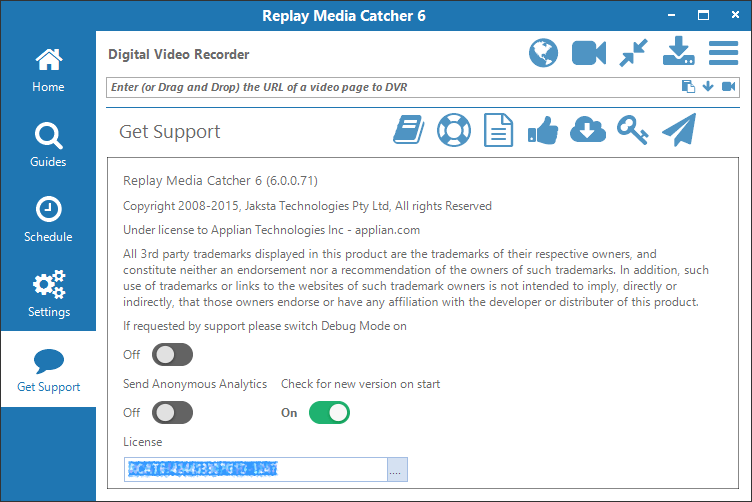
In the Get Support tab, you can learn more about Replay Media Catcher 6 as well as provide useful information to technical support if there is a problem.
 User Guide: Opens up this user guide
User Guide: Opens up this user guide Support Page: Opens your web browser to the main Applian Replay Media Catcher support website.
Support Page: Opens your web browser to the main Applian Replay Media Catcher support website. EULA: Opens the End User License Agreement.
EULA: Opens the End User License Agreement. Acknowledgements: Opens the About website for Applian, detailing company information.
Acknowledgements: Opens the About website for Applian, detailing company information. New Version: Checks to see if a new version of the software is available
New Version: Checks to see if a new version of the software is available Reset Registration: Clears the current registration informaion so that you can enter a new or different code. (Won't appear if you are in trial mode).
Reset Registration: Clears the current registration informaion so that you can enter a new or different code. (Won't appear if you are in trial mode). Send Logs: This button will generate a Zip file containing diagnostic information. Most useful when debug mode has been turned on prior to an even requiring support.
Send Logs: This button will generate a Zip file containing diagnostic information. Most useful when debug mode has been turned on prior to an even requiring support.
- If requested by support please switch Debug Mode on: In debug mode, more details will be saved to the recording logs. If you are having trouble, turn this setting On, reproduce the problem, and then generate support logs with the Send Logs button. This setting gets turned off when restarting RMC, so it is only valid for the current session.
- Send Anonymous Analytics: To help improve RMC, you can have anonymous information sent to our server. Data collected includes the functions of RMC you use the most as well as sites visited. No customer or license information is included.
- Check for new version on start: If On, RMC will check to see if you are using the most current version of the software. This helps you stay up-to-date with the latest streaming formats and bug fixes.
- License: If you are registered, your license code will appear here. If you are not registered, you can click the ellipsis (...) at the end of the field to open the registration window.
Converting Media Formats
On the Home tab, beneath the main toolbar, you will find the conversion preset pulldown.

Selecting a preset from this drop down means that any download, recording or conversion started after the preset is changed will be converted to that format. If you don't wish for a conversion to occur, select Don't Convert, and you will see No Conversion Setting.
Conversions of media can either be done automatically, as mentioned above, or on-demand. To do an on-demand conversion, choose a conversion setting and then right-click on the media in the Home tab and select Convert. Alternately, if the media is already selected, you can choose Convert from the Main Menu  . If you are scheduling a recording, you can set it up to automatically do a conversion (see Schedule for more information).
. If you are scheduling a recording, you can set it up to automatically do a conversion (see Schedule for more information).
Quick Conversion to MP3
If you have a media file or files that you want to convert to MP3, you do not need to set a global conversion setting. Simply, select the files to be converted in the Home tab. Next, either right-click or use the Main menu to choose Save to MP3. Your selected files will then be converted to a high quality MP3.
Importing Media For Conversion
You may have media from other sources that you would like to convert to a different format. First, import the media into RMC6. This can be done either via dragging & dropping the file from Windows onto the RMC6 file listing, or via the Main Menu Import option (Alt+i on the keyboard).
Note: Media imported into RMC6 will stay in its original location. Conversions of the media will be saved to the same location. The imported media will not be moved to the RMC6 Output Folder.
Then, select a conversion setting from the pulldown and choose Convert from the right-click or Main menu.
Changing and Adding New Conversion Settings
You have full control over the preset conversion settings and can create, delete and modify them. However as new devices and formats are released, preset conversion settings will be updated, and these are automatically downloaded when you start the application.
To create, delete or edit existing preset conversion settings, select the Configure menu item from the drop-down. The Conversion Presets dialog will appear.

- Select the preset conversion setting you wish to modify from the drop-down list at the top.
 Copy button: Will prompt you for a new preset name and create that preset. Your new conversion setting will be saved in the same pulldown location.
Copy button: Will prompt you for a new preset name and create that preset. Your new conversion setting will be saved in the same pulldown location. Save button: Will save any changes.
Save button: Will save any changes. Delete button: Will delete the selected preset.
Delete button: Will delete the selected preset. Reset button: Will reset all presets to their default settings.
Reset button: Will reset all presets to their default settings.
To add a new format without deleting the default, simply click the Copy button first, give your new format a name, then edit as you wish.
The conversion settings follow FFMPEG conventions.
Advanced Internet Downloading Settings
In general, the Advanced settings will not need to be adjusted. These settings are accessed via the Advanced button on the Settings -> Internet Downloads page. You need to turn Off and back On the AUTO setting for any changes to take affect.
- Ad Blocker
Downloading ads can be annoying. Enable Ad blocking, and video ads from the list of domains in the Ad Blocker will not be downloaded.

Type in the name of an ad serving domain and press the Add button. To no longer block a domain, select it from the listing and press the Delete button.
- HDS

Adobe HTTP Dynamic Streaming (HDS) is an adaptive streaming protocol which means that the quality of the media displayed changes based on your internet connection. If you are encountering many HDS streams that fail to download, you may want to set RMC6 to record them all.
- HTTP

- To increase the speed of HTTP downloads, Replay Media Catcher can use a method called segmented downloading. This is where a single download is broken to several smaller downloads (segments) and each is downloaded at the same time.
- The speed boost obtained is dependent on your network connection, your computer and the server streaming the video or audio.
- Here you can configure the Max number of segments for each download, and the Minimum segment size for each segment.
- If a download is failing and you see in the Progress log that segments are failing, change the Max number of segments to 1.
Audio and video streamed over the HTTP protocol is identified by the Content Type. You can add and remove Content Types and the associated File Extensions.
Reinstall FireFox HTTPS Scanner: Firefox updates sometimes delete our certificate for downloading over HTTPS. Click Reinstall to add the certificate again.
- Naming Rules
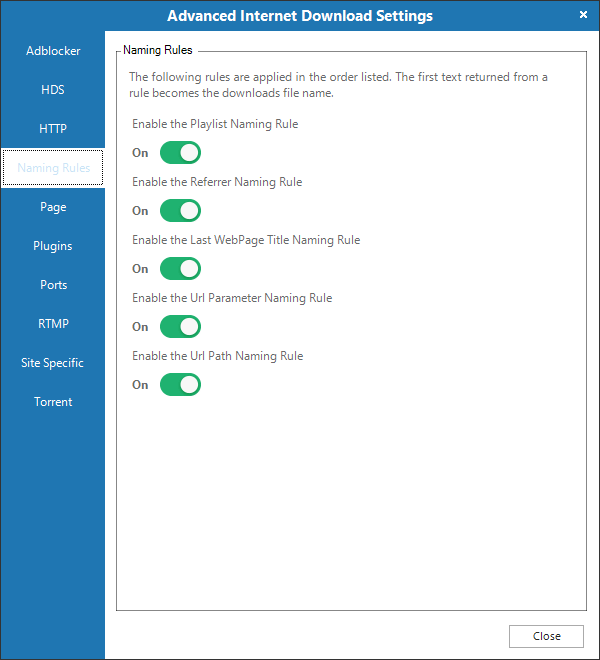
- Enable the Playlist Naming Rule: Video and music players sometimes use "playlist files" to obtain the stream(s) to play, and these can contain title information. Replay Media Catcher will match stream URL's against any detected playlists to see if a title can be found. This is common for music sites (e.g. Pandora)
- Enable the Referrer Naming Rule: HTTP requests can contain what is termed a referrer which identifies the URL of the page which made the request. If the detected streams request contains a referrer then the title of this page will be used as the name.
- Enable the Last Web Page Title Naming Rule: The application keeps track of all visited HTML pages. The domain name of a stream's URL will be used to look up the last page visited in that domain and that page title will be used. Extended HTTP Title lookup will occur once the download is complete.
- Enable the URL Parameter Naming Rule: The stream's URL is searched for parameters such as title= or name=. If one is found then that will be used as the name. Extended HTTP Title lookup will occur once the download is complete.
- Enable the URL Path Naming Rule: The file part of the stream's URL will be used. For example http://www.applian.com/some/path/file.mp3 the name would be file.mp3. Extended HTTP Title lookup will occur once the download is complete.
YouTube has an additional naming rule, which can be found in Site Specific advanced options.
- Page
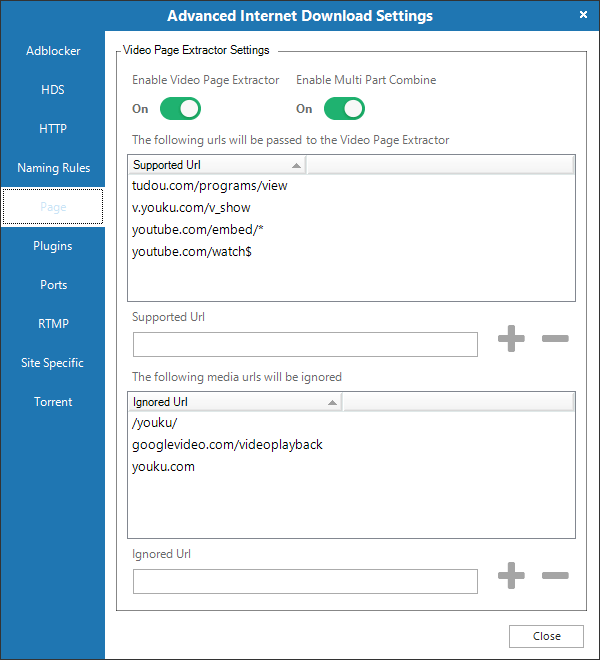
Some videos are available in multiple resolutions and qualities. The Video Page Extractor can search for the multiple video options and allow you to choose which you want to download. If you encounter a website that offers multiple resolutions (as determined by observing multiple versions being download in Auto mode) you can add the URL here.
Some videos are sent to your browser in multiple parts, requiring you to watch (nearly) the entire video for the whole video to be saved. In these cases, add the URL to the Supported Url listing, and RMC6 will attempt to grab all the parts at once and combine them into a single file.
- Plugins
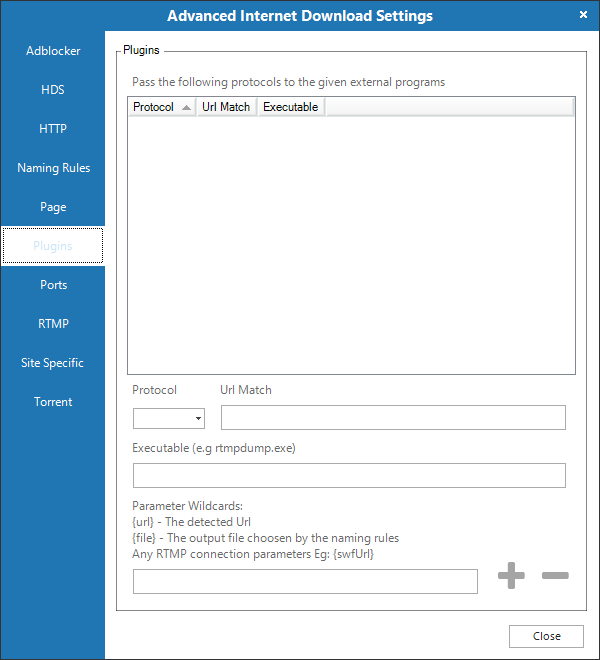
Replay Media Catcher supports adding third party plug-ins like rtmpdump to handle the downloading of streams. If Replay Media Catcher cannot download or record a file, installing a plug-in can give it extended power.
- Protocol: Select the protocol you would like to pass to the plug-in.
- Url Match: Enter part of the URL to match.
- Executable: Enter the plug-in's executable name and place the executable in the Replay Media Catcher installation folder.
- Parameter Wildcards: Enter the executable's parameters. Use the pattern's URL and file as indicated on the dialog. Other parameters should be hard coded.
Click the Add button to save.
- Ports

In Auto mode, RMC6 will watch the listed ports and protocols for data that matches the HTTP media types in Advanced HTTP settings as well as HDS and RTMP streams.
- RTMP
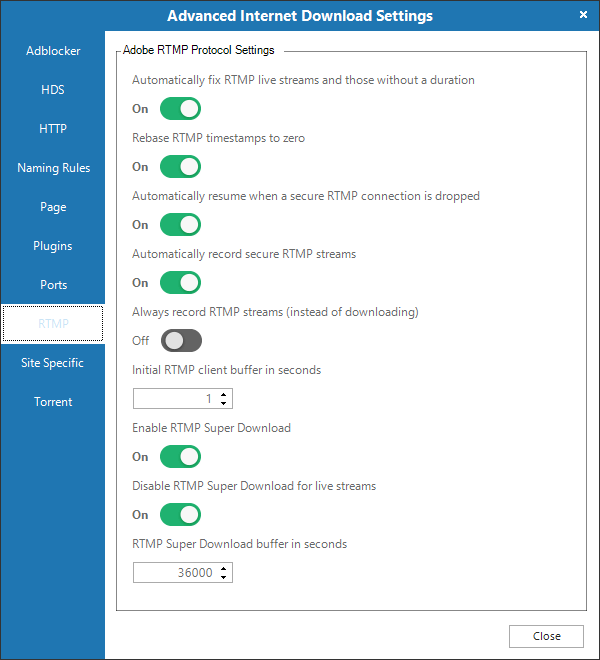
Live FLV streams such as webcams sometimes send incorrect timestamps. This means the file created for the download plays back incorrectly. The following settings allow you to control how these are fixed.
- Automatically fix live streams and those without a duration: Enable this and such streams will be fixed.
- Rebase timestamps to zero: Enable this and all timestamps will be rebased so the file starts at 0 time.
Some sites that stream RTMP will also try and secure it with a technology called SWF Verification. It is illegal for our products to respond to SWF Verification requests so we ignore them. This will cause the server connection to then drop after a period of time. The following settings allow you to control how these secure streams are handled.
- Automatically resume when a secure RTMP connection is dropped: Enable this and the download will automatically restart each time the connection is dropped.
- Automatically record when a secure RTMP stream is detected: Enable this and the application will automatically record the stream, instead of attempting to download it
- Always record RTMP streams (instead of downloading): Enable this and the application will always record RTMP streams.
The RTMP protocol allows us to request the amount of data the server should send in each chunk. Requesting a large chunk means that in many instances the download will happen much faster than the playback speed. The following settings allow you to control how this Super Download feature works.
- Initial client buffer size (seconds): The number of seconds of data the server should send.
- Enable Super Download: Check to enable this feature.
- Disable RTMP Super Download for live streams: Check this to disable this feature for live streams.
- RTMP Super Download buffer in seconds: The number of seconds of data the server should send when attempting a Super Download.
- Site Specific
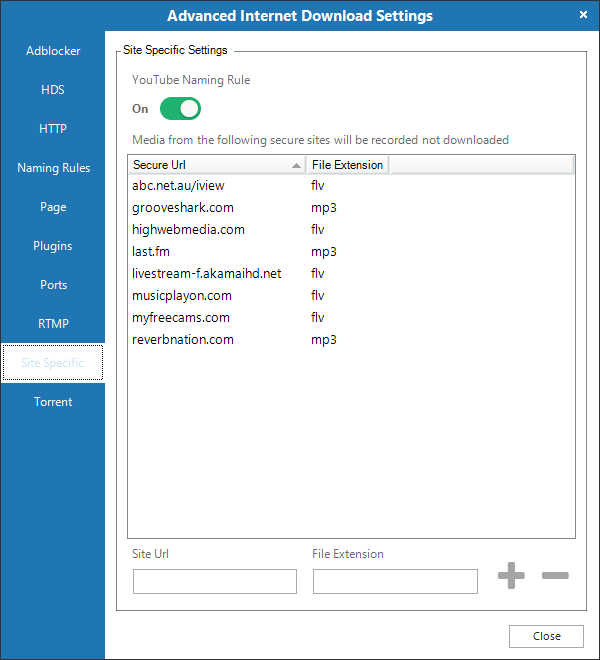
- YouTube Naming Rule: Use a special rule to accurately name YouTube downloads
- Some sites do not allow multiple connections to them or use URL s that are valid only the first time they are used (by your browser). Some sites use protection technologies (including SWF Verification and other site specific technologies) that mean it is only possible to record. We refer to them as secure sites. Media Recorder can automatically record instead of downloading secure sites. Add the URLs for secure sites here. During a recording, the entire media must completely play in your browser for it to be saved by RMC6.
- Torrent

Replay Media Catcher can download torrents by clicking appropriate links on websites. Replay Media Catcher's torrent and magnet link downloader (based upon Aria2) is controlled via the following settings.
- Aria2 Port: The port that aria2 will listen on
- Seed Time: The number of minutes after a download is complete that it will seed for.
- Allow Overwrite: If checked then any existing file will be overridden
- Enable DHT: Check to enable distributed hash table lookups
- DHT Entry Point: Sets the host and port as an entry point to IPv4 DHT network.
- DHT Listen Port: Sets the UDP listening port used by DHT(IPv4, IPv6) and UDP tracker. Multiple ports can be specified by using comas - for example: 6881,6885. You can also use hyphens to specify a range - for example: 6881-6999. Commas and hyphens can be used together.
Keyboard Shortcuts
Alt + X = Start or Stop Auto mode Stream Downloading
Alt + R = Start or Stop audio recording
Alt + S = Split audio recording
Escape = Cancel selected download
Del = Delete selected recording(s) from computer
F2 = Rename selected download/recording.
Ctrl + R = Remove selected file(s) from the file listing, but don't delete from computer
Enter = Play selected download/recording
Ctrl + C = Converted selected files to format specified in global conversion settings
Ctrl + M = Converted selected files to MP3
Add = Combine multiple selected files
Ctrl + F = Fix FLV
F5 = Restart download (only possible for some download streams)
Ctrl + I = Import selected recording(s) into iTunes library
Ctrl + W = Import selected recording(s) into Windows Media Player library
Ctrl + O = Show selected file in Windows File Explorer
Alt + A = Show the album artwork in the Properties Window
Alt + L = Show the song lyrics in the Properties Window
Alt + T = Lookup ID3 tags (artist, song, album, etc) for selected song(s)
Alt + Enter = Open the download/recording properties window
Alt + I = Open file browser to Import songs into Replay Music
F1 = Open web browser to the Replay Media Catcher support page
Alt + F4 = Quit
Ctrl + L = Place cursor in the URL bar
Ctrl + S = Open Settings tab
Ctrl + tab = Next tab
Ctrl + shift + tab = Previous tab
Ctrl + v = With the file listing selected, the paste command can be used to import media files from the clipboard. Additionally, if you have copied multiple URLs from a text file, those can be queued for downloading.
The Application recording mode requires Secure Boot to be disabled on Windows 8 systems. The benefit of the Application recording mode is that each audio source can be isolated, providing a clean recording. You can still recording in Stereo Mix mode without disabling Secure Boot, but then the recordings might overlap with other audio playing on your computer, such as system sounds. You will need to be careful to turn off system sounds and not have any other audio play during a recording.
You might want to print out these instructions or have them open on a mobile/secondary device since disabling Secure Boot involves restarting your computer. You might also want to bookmark this page to return to after disabling Secure Boot.
- Press the Windows key + C, or (if you have a touchscreen) swipe in from the right edge of the screen to open your Charms.
- Click Settings.
- Click Change PC Settings.
- In PC Settings, select Update and Recovery.
- In the Update and Recovery screen, click Recovery at the left.
- Under Advanced Startup, click Restart now. The system will restart and show the Windows 8 boot menu.
- In the boot menu, select Troubleshoot.
- In the Troubleshoot menu, select Advanced options.
- In the Advanced options menu, select UEFI Firmware Settings.
- Click Restart button to boot into UEFI BIOS Setup screen.
- Each manufacturer lays out the BIOS differently. Look through the BIOS settings and disable Secure Boot. Save settings and exit.
Here is a video walking through the steps: http://www.youtube.com/watch?v=XZcYbxOcPV0
Once Secure Boot is turned off, you will be able to use the Applications recording method to get clean recordings.
![]()
![]()
![]()
![]() and selecting Tutorial.
and selecting Tutorial.



 You must start monitoring BEFORE you watch or listen to media that you want to capture. First, make sure that the capture method at the top right is set to Stream Downloader, as seen to the right. Click on the AUTO switch before browsing to the media you want to capture. Once clicked, the AUTO switch will turn slide right and turn green
You must start monitoring BEFORE you watch or listen to media that you want to capture. First, make sure that the capture method at the top right is set to Stream Downloader, as seen to the right. Click on the AUTO switch before browsing to the media you want to capture. Once clicked, the AUTO switch will turn slide right and turn green ![]() .
.![]() clipboard button at the end of the URL field. Then click the Enter key or press the
clipboard button at the end of the URL field. Then click the Enter key or press the ![]() download arrow button. RMC6 will visit the URL and attempt to grab streaming media from it. The final
download arrow button. RMC6 will visit the URL and attempt to grab streaming media from it. The final ![]() DVR button in the bar will launch a Digital Video Recording of media at the URL (please refer to Capture Method - Digital Video Recorder for more information).
DVR button in the bar will launch a Digital Video Recording of media at the URL (please refer to Capture Method - Digital Video Recorder for more information).
 Audio recording is a great way to capture music when downloading fails. Saving audio using this method will work, regardless of the format, protocol, or web site of the media.
Audio recording is a great way to capture music when downloading fails. Saving audio using this method will work, regardless of the format, protocol, or web site of the media.![]() RECORD button will appear at the top left.
Once clicked, the RECORD button will turn to a red square STOP button
RECORD button will appear at the top left.
Once clicked, the RECORD button will turn to a red square STOP button ![]() , but RMC6 will be actively monitoring for audio media. When RMC6 is actively recording audio, the VU meter will animate at the lower left of the interface, and the recording will be seen in the Home tab.
, but RMC6 will be actively monitoring for audio media. When RMC6 is actively recording audio, the VU meter will animate at the lower left of the interface, and the recording will be seen in the Home tab.
![]() .
.
![]() or by pressing the + key on your keyboard's number pad.
or by pressing the + key on your keyboard's number pad.
![]() in the toolbar. The main interface will disappear and the Small Interface will appear. The progress of active recordings will appear in a movable box at the lower right of the screen. You can turn off this option in Settings -> Personalization -> "Display progress alerts when minimized". The Small interface can be dragged to different locations, and you can return to the Main Interface by clicking
in the toolbar. The main interface will disappear and the Small Interface will appear. The progress of active recordings will appear in a movable box at the lower right of the screen. You can turn off this option in Settings -> Personalization -> "Display progress alerts when minimized". The Small interface can be dragged to different locations, and you can return to the Main Interface by clicking ![]() .
. ![]() in the toolbar. You can also change the location via Settings -> Output Folder.
in the toolbar. You can also change the location via Settings -> Output Folder. Videos from some streaming websites cannot be directly downloaded or recorded using the Stream Capture method. For these cases, Replay Media Catcher 6 has a powerful Digital Video Recorder feature. In this mode, only one recording can be done at a time. From the Capture Method icon in the top right toolbar, choose Digital Video Recorder. The Digital Video Recorder feature is available on systems running Windows Vista and above.
Videos from some streaming websites cannot be directly downloaded or recorded using the Stream Capture method. For these cases, Replay Media Catcher 6 has a powerful Digital Video Recorder feature. In this mode, only one recording can be done at a time. From the Capture Method icon in the top right toolbar, choose Digital Video Recorder. The Digital Video Recorder feature is available on systems running Windows Vista and above.![]() clipboard icon can also be used to paste in a URL that you have copied from a web browser. Then press the
clipboard icon can also be used to paste in a URL that you have copied from a web browser. Then press the ![]() DVR button to the right in the URL bar. RMC6 will go to the site and attempt to make a recording of the video there. If the recording fails, you may need to use our DVR Browser to specifically start the recording, especially if login credentials are necessary.
DVR button to the right in the URL bar. RMC6 will go to the site and attempt to make a recording of the video there. If the recording fails, you may need to use our DVR Browser to specifically start the recording, especially if login credentials are necessary.![]() . Our DVR Browser window will open with a convenient list of popular video streaming websites.
. Our DVR Browser window will open with a convenient list of popular video streaming websites.
![]() Home button will return you to this main listing.
Home button will return you to this main listing.![]() REC button. The browser window will close, and a recording will be done in the background. In the lower left corner of the RMC6 interface, there will be a mini live view of the recording.
REC button. The browser window will close, and a recording will be done in the background. In the lower left corner of the RMC6 interface, there will be a mini live view of the recording.


![]() Reset button at the right, under the main toolbar.
Reset button at the right, under the main toolbar.







![]()
![]() . If you are scheduling a recording, you can set it up to automatically do a conversion (see Schedule for more information).
. If you are scheduling a recording, you can set it up to automatically do a conversion (see Schedule for more information).









